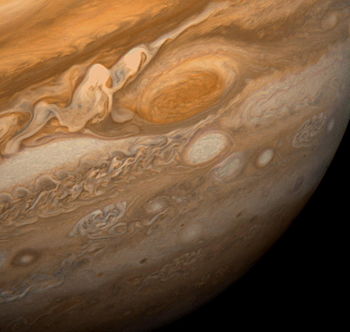Jupiter (planet)
Jupiter is the fifth planet from the Sun. It is a gas giant (also known as the Jovian planet).
Parameters for classification as a planet
Jupiter is classified as a planet by the International Astronomical Union for meeting the following criteria:[1]
- Orbits the sun;
- Has mass sufficient for its gravity to form a nearly round shape;
- Has mass sufficient for gravity to clear a path in its orbit.
Physical characteristics
Jupiter is a little more than five times further away from the Sun than Earth (5.2 AU) and is the most massive of the planets with a total mass of about 318 times that of Earth (318 Earth masses) Its total mass is about 2.5 times all the other planets combined.
- Equatorial Radius: 71,492 km
- Volume: 1.4255 X10e15 km^3
- Mass: 1.8987 X10e27 kg[2]
It is composed largely of hydrogen and helium. Jupiter's strong internal heat creates a number of semi-permanent features in its atmosphere, such as cloud bands and the Great Red Spot.
Jupiter's great spot
Jupiter's red spot is believed to be a giant hurricane a strom rotating within the planet clouds. The first recorded observation was made by Italian-French astronomer Jean-Dominique Cassini in 1655. Three-hundred years later it is still active. The spot is a cold, high-pressure area, 2 to 3 times the diameter of Earth. Its outer edges make a complete rotation in a counter clock-wise motion about once every six days.[3]
The red spot rises about 8 km above the surrounding clouds. Its red colour is a mystery but current theories posit that it may be caused by material dredged up from the surface of the planet.[4]
Oval BA
Jupiter shows a number of other storms that are much smaller than the Great Red Spot. However, in June of 2000, a number of these smaller storms were seen to coalesce and form a larger storm center. The storm, labled Oval BA (aka Red Spot Jr.) has since developed a reddish colour and looks very much like the Great Red Spot though much smaller.[4]
Rotational characteristics
Jupiter has a rotational period (a complete rotation on its axis) of 9.842 hours and a polar tilt of 3°.[5]
Orbital characteristics
Jupiter has an orbital period (sidereal year) of 11.68 earth years. Jupiter has an average distance from the Sun of 778,412,020 km.[6] At is closest approach to the Sun (perihelion) it is nearly 5 times the distance of the Earth from the Sun (4.95 AU). At its furthest distance from the Sun (aphelion) it is 5.45 AU from the Sun.[5]
Natural satellites
Jupiter has sixty-three satellites. The four largest, Ganymede, Callisto, Io, and Europa show similarities to the terrestrial planets, such as volcanism and internal heating.[7] Ganymede, the largest satellite in the Solar System, is larger than Mercury.
References
- ↑ Honey, I Shrunk the Solar System NASA. “The International Astronomical Union has decided that, to be called a planet, an object must have three traits. It must orbit the sun, be massive enough that its own gravity pulls it into a nearly round shape, and be dominant enough to clear away objects in its neighborhood.”
- ↑ Jupiter NASA
- ↑ Galileo, Cassini, and the Great Red Spot NASA
- ↑ 4.0 4.1 Jupiter's new red spot NASA
- ↑ 5.0 5.1 The orbits of the planets National Maritime Museum
- ↑ Jupiter NASA
- ↑ Pappalardo, R T (1999). Geology of the Icy Galilean Satellites: A Framework for Compositional Studies. Brown University. Retrieved on 2006-01-16.
External Links
- Jupiter's Great Red Spot Hubble Heritage Project

